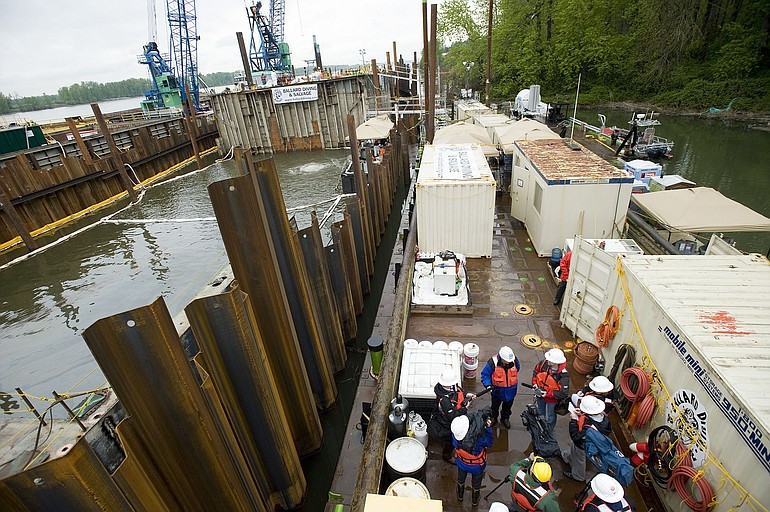New law allows state to get tougher with derelict vessel owners
With its stern finally afloat, the dismantling of the derelict barge Davy Crockett is picking up speed.
Officials from the U.S. Coast Guard, the Washington Department of Ecology and the contractor in charge of demolition led a news media tour of the project Thursday that offered the first close-up look at the deconstruction of the 431-foot-long converted Liberty ship since work began.
The dismantling and cleanup of the barge was federalized in January after an oil sheen from the abandoned vessel spread 15 miles downstream.
The ship on the Columbia River between Vancouver and Washougal began leaking oil after the owner, Brett Simpson of Ellensburg, undertook illegal salvage operations while it was afloat near the Washington shore.
By the time the Coast Guard took over the project, damage to the vessel had caused it to buckle, and the stern sank. Workers pumped 500,000 gallons of river water into the hold of the 239-foot-long stern section to stabilize it and keep the barge from breaking up.
In late April, divers employed by Seattle-based Ballard Diving and Salvage cut the stern section free. Last Thursday, workers began pumping out the ballast water, and by Saturday the stern section was afloat and stable, said Coast Guard Capt. Daniel LeBlanc, the incident commander.
The most challenging part of the demolition will involve cutting away the double-bottom sections of the hull, where tanks are likely to be contaminated with heavy bunker oil. Because the barge’s midsection is submerged, divers will work underwater in the dark, in close quarters, as they cut up the sections with underwater torches. “Everything they do is by touch and feel,” LeBlanc said.
The Davy Crockett is encircled by a cofferdam composed of nearly 1,150 linear feet of metal sheet pilings and a secondary silt barrier, both anchored to the river bottom. Completed two and a half weeks ago, it’s designed to contain PCB-tainted oil and bunker fuel and prevent pollutants from escaping into the river.
A 150-foot “deflection” wall protects the cofferdam from river debris.
Contractors decided in late March to dismantle the Davy Crockett where it sits after officials failed to find a dry dock willing to accept the dismantled vessel cut in two pieces.
“Nobody preferred to cut this thing up in the river,” said Jim Sachet of the Washington Department of Ecology. But the process has proceeded smoothly, he said. Testing of river water upstream, downstream and alongside the barge has shown no oil or heavy metal contamination from the demolition, he said, and no fish or sea lions have been sighted inside the cofferdam.
“So far, we’ve gone through two sampling cycles and haven’t seen anything of concern,” Sachet said.
The cofferdam was built to withstand even flood-level conditions on the river, he said.
Oil-contaminated water removed from tanks on the barge is filtered on-site. About 1.1 million gallons of the oil-water mixture are stored on a tank barge on the Willamette River awaiting further processing, possibly at a water treatment plant in Portland or Vancouver. In the future, Sachet said, filtered water may be returned to the river.
In addition, he said, as the ship is dismantled, each piece of steel will be cleaned using high-pressure washers.
“I do expect oil will be released from the midsection” as it is cut apart underwater, Sachet said, but that too should be contained by the cofferdam.
Steel salvaged from the hulk — some 2,500 tons — will be sold to Schnitzer Steel in Portland. With scrap steel going for $105 to $120 a ton, the proceeds — $300,000 max — won’t go far in paying the rising price tag for the demolition operation, the most expensive shipwreck in Washington history.
So far, the cost of the salvage operation has climbed to $13 million, and that figure will rise, LeBlanc said. The operation is being paid for by the Oil Spill Liability Trust Fund, a federal fund created by a tax on petroleum products. Simpson has not participated in the cleanup and is the subject of a parallel federal criminal investigation.
Salvage work on the stern and midsection will continue through June, LeBlanc said. Dismantling of the bow could push the project into mid-July.
Kathie Durbin: 360-735-4523 or kathie.durbin@columbian.com.




